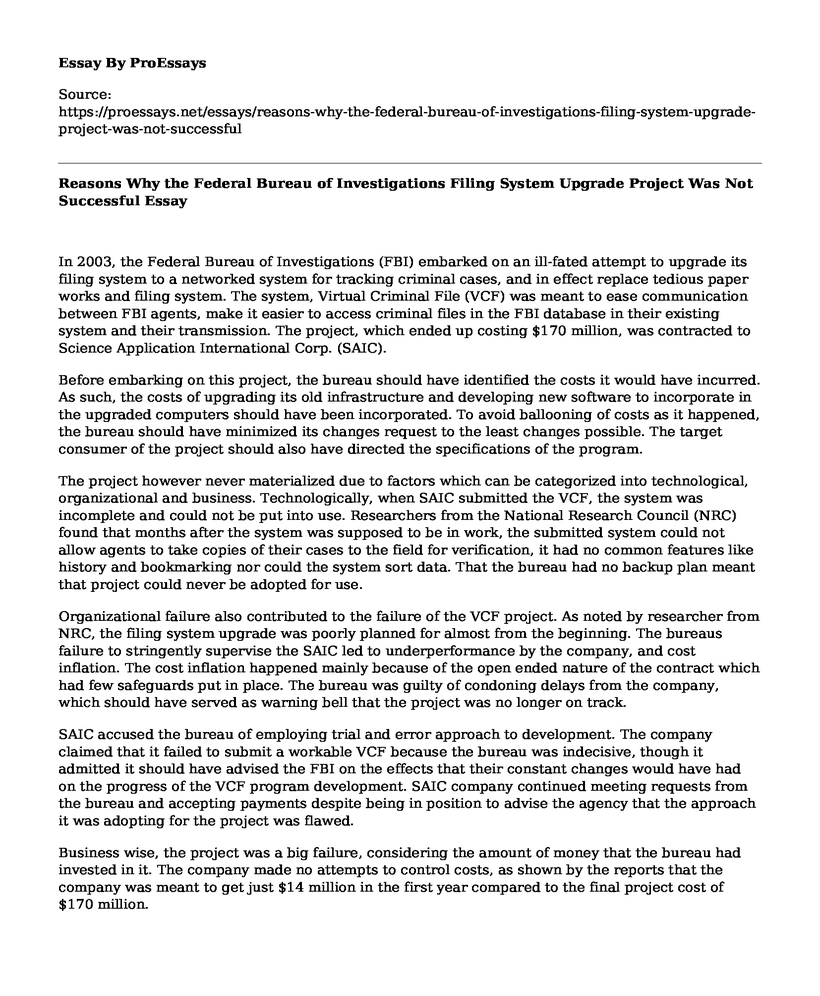In 2003, the Federal Bureau of Investigations (FBI) embarked on an ill-fated attempt to upgrade its filing system to a networked system for tracking criminal cases, and in effect replace tedious paper works and filing system. The system, Virtual Criminal File (VCF) was meant to ease communication between FBI agents, make it easier to access criminal files in the FBI database in their existing system and their transmission. The project, which ended up costing $170 million, was contracted to Science Application International Corp. (SAIC).
Before embarking on this project, the bureau should have identified the costs it would have incurred. As such, the costs of upgrading its old infrastructure and developing new software to incorporate in the upgraded computers should have been incorporated. To avoid ballooning of costs as it happened, the bureau should have minimized its changes request to the least changes possible. The target consumer of the project should also have directed the specifications of the program.
The project however never materialized due to factors which can be categorized into technological, organizational and business. Technologically, when SAIC submitted the VCF, the system was incomplete and could not be put into use. Researchers from the National Research Council (NRC) found that months after the system was supposed to be in work, the submitted system could not allow agents to take copies of their cases to the field for verification, it had no common features like history and bookmarking nor could the system sort data. That the bureau had no backup plan meant that project could never be adopted for use.
Organizational failure also contributed to the failure of the VCF project. As noted by researcher from NRC, the filing system upgrade was poorly planned for almost from the beginning. The bureaus failure to stringently supervise the SAIC led to underperformance by the company, and cost inflation. The cost inflation happened mainly because of the open ended nature of the contract which had few safeguards put in place. The bureau was guilty of condoning delays from the company, which should have served as warning bell that the project was no longer on track.
SAIC accused the bureau of employing trial and error approach to development. The company claimed that it failed to submit a workable VCF because the bureau was indecisive, though it admitted it should have advised the FBI on the effects that their constant changes would have had on the progress of the VCF program development. SAIC company continued meeting requests from the bureau and accepting payments despite being in position to advise the agency that the approach it was adopting for the project was flawed.
Business wise, the project was a big failure, considering the amount of money that the bureau had invested in it. The company made no attempts to control costs, as shown by the reports that the company was meant to get just $14 million in the first year compared to the final project cost of $170 million.
Cite this page
Reasons Why the Federal Bureau of Investigations Filing System Upgrade Project Was Not Successful. (2021, Jun 23). Retrieved from https://proessays.net/essays/reasons-why-the-federal-bureau-of-investigations-filing-system-upgrade-project-was-not-successful
If you are the original author of this essay and no longer wish to have it published on the ProEssays website, please click below to request its removal:
- Gun Control: An American Right Essay
- Anomie, Social Change, and Crime Essay
- Design of the United States Constitution Essay
- Wells Fargo Scandal Essay Example
- Essay Sample on Child Abduction
- Essay Sample on IPv6: Enabling Robust Internet with Enhanced Features
- Unveiling Wrongful Convictions: Causes, Consequences, and Reforms in the United States - Paper Sample







